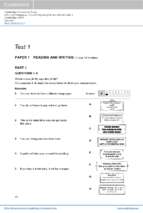VIETNAM NATIONAL UNIVERSITY, HANOI
UNIVERSITY OF LANGUAGE AND INTERNATIONAL STUDIES
FACULTY OF POSTGRADUATE STUDIES
*****************
TRỊNH THU HƢƠNG
USING SHADOWING TO IMPROVE LISTENING SKILLS
FOR GRADE 10 MIXED-ABILITY STUDENTS
AT A HIGH SCHOOL IN HANOI
(Sử dụng kỹ thuật bắt chƣớc để cải thiện kỹ năng nghe
cho học sinh lớp 10 có trình độ khác nhau
tại một trƣờng cấp ba ở Hà Nội)
M.A MINOR PROGRAMME THESIS
Field: English Teaching Methodology
Code: 8140231.01
HANOI - 2020
VIETNAM NATIONAL UNIVERSITY, HANOI
UNIVERSITY OF LANGUAGE AND INTERNATIONAL STUDIES
FACULTY OF POSTGRADUATE STUDIES
*****************
TRỊNH THU HƢƠNG
USING SHADOWING TO IMPROVE LISTENING SKILLS
FOR GRADE 10 MIXED-ABILITY STUDENTS
AT A HIGH SCHOOL IN HANOI
(Sử dụng kỹ thuật bắt chƣớc để cải thiện kỹ năng nghe
cho học sinh lớp 10 có trình độ khác nhau
tại một trƣờng cấp ba ở Hà Nội)
M.A MINOR PROGRAMME THESIS
Field: English Teaching Methodology
Code: 8140231.01
Supervisor: Prof. Dr. Hoàng Văn Vân
HANOI - 2020
DECLARATION
I declare that this minor thesis named “Using shadowing to improve
listening skills for grade 10 mixed-ability students at a high school in
Hanoi” is the study of my own research and the substance of the thesis has
not been submitted for a degree to any other university or institution.
Hanoi, 2020
Trịnh Thu Hƣơng
i
ACKNOWLEDGEMENTS
This thesis would not have been accomplished without the assistance of
people who I would like to express my deep gratitude.
Firstly, I would like to express my thankfulness to Prof. Dr. Hoàng Văn
Vân, my supervisor, for his wholehearted support, helpful comments, and
insightful guidance towards the completion of this study.
Secondly, my special thanks are also sent to all lecturers, my
classmates, as well as my colleagues for their precious comments and for their
continuous encouragements.
Thirdly, I appreciate the cooperation given to me by students at Hoang
Mai High School. Without their sincere participation and valuation opinions,
the study would not have been accomplished.
Last but not least, I would like to express my deepest thanks to my
family for their continuous support during my time of fulfilling this thesis.
ii
ABSTRACT
Listening is one of the most crucial skills in learning a foreign
language, which has a great effect on learners’ failure or success. Shadowing
is one of the effective ways to improve listening skills for the mixed-ability
students at Hoang Mai High School, where the author was conducted this
research. The research was carried out by using two data collection
instruments, including questionnaires and pre- and post-tests. The results
revealed that all of the students taking part in the research have a positive
attitude toward this method and they think shadowing made them prefer
learning English more, especially listening. Additionally, their scores for
listening skills were improved dramatically in the previous school year.
Hopefully, this study will make a relative contribution to improve their
listening skills, as well as teachers, have one more effective technique to
make their listening lessons more interesting.
iii
LIST OF ABBREVIATIONS
EFL:
English as a Foreign Language
ESL:
English as the Second Language
L2:
Second language
MOET:
The Ministry of Education and Training
LIST OF TABLES AND FIGURES
LIST OF TABLES
Table 1: Paired Samples Statistics
Table 2: Paired Samples Correlations
Table 3: Paired Samples Test
Table 4: Students’ evaluation of shadowing technique
LIST OF FIGURES
Figure 1: Comparison of students’ performance in the pre-test and post-test
iv
TABLES OF CONTENTS
DECLARATION ............................................................................................ i
ACKNOWLEDGEMENTS............................................................................ ii
ABSTRACT .................................................................................................. iii
LIST OF ABBREVIATIONS ....................................................................... iv
CHAPTER 1: INTRODUCTION ................................................................... 1
1. Rationale of the study ................................................................................. 1
2. Aims of the study ....................................................................................... 2
3. Research questions ..................................................................................... 3
4. The scope of the study ................................................................................ 3
5. Research methods ....................................................................................... 3
6. Design of the study ..................................................................................... 4
CHAPTER 2: LITERATURE REVIEW ........................................................ 5
2.1. Theoretical background ........................................................................... 5
2.1.1. Definitions of listening ..................................................................... 5
2.1.2. The significance of listening ............................................................. 7
2.1.3. The processes of listening ............................................................... 10
2.1.4. Listening skills ............................................................................... 12
2.1.5. Difficulties in learning listening skills ............................................ 13
2.2. Shadowing ............................................................................................. 15
2.2.1. Definition of shadowing ................................................................. 15
2.2.2. Advantages of shadowing ............................................................... 17
2.2.3. Teaching procedures by using shadowing ....................................... 20
2.3. Mixed-ability classes ............................................................................. 20
2.3.1. Definition of mixed-ability classes ................................................. 20
2.3.2. Challenges of mixed-ability classes ................................................ 22
2.3.3. Strategies for teaching mixed-ability classes ................................... 24
v
2.4. Previous studies on the use of shadowing .............................................. 26
2.5. Summary ............................................................................................... 28
CHAPTER 3: RESEARCH METHODOLOGY ........................................... 29
3.1. Setting of the study ................................................................................ 29
3.2. Materials ............................................................................................... 30
3.3. Participants ............................................................................................ 30
3.4. Data collection instruments ................................................................... 31
3.4.1. Pre-test and post-test ....................................................................... 31
3.4.2. Questionnaire.................................................................................. 31
3.5. Data collection procedure ...................................................................... 32
3.6. Summary ............................................................................................... 32
CHAPTER 4: FINDINGS AND DISCUSSION ........................................... 33
4.1. Findings................................................................................................. 33
4.1.1. Research question 1 ........................................................................ 33
4.1.2. Research question 2 ........................................................................ 37
4.2. Discussion ............................................................................................. 42
CHAPTER 5: CONCLUSION ..................................................................... 44
5.1. Recapitulation ....................................................................................... 44
5.2. Limitations of the study ......................................................................... 45
5.3. Suggestions for further studies............................................................... 46
REFERENCES............................................................................................. 47
APPENDICES ................................................................................................ I
vi
CHAPTER 1: INTRODUCTION
1. Rationale of the study
It cannot be denied that English is the dominant language because of its
contributions in many fields such as technology, science, education,
entertainment, economy, culture and so on. Because of this reason, more and
more people especially young learners who wish to master English; and the
number is rapidly increasing day by day. English not only broadens students’
knowledge but also helps them have many good chances to develop
themselves. Moreover, the use of English among young Vietnamese students
is becoming more and more popular.
In recent years, English has been a mandatory subject in curriculums in
the educational system of Vietnam. English is regarded as a challenging
subject as well as practical demand for learners to achieve their better study or
their success in the near future. However, obtaining a good language
competence is not simple for all learners; it requires a huge effort from them.
Although each one of the four language skills – listening, speaking, reading,
and writing, has their own characteristics, listening is said to be the most
challenging skill to learners. The factors that affect the learners’ listening
ability
are
various
such
as
pronunciation,
stress,
intonation
or
misunderstanding the information of speakers, etc. In order to improve such
difficulties, it is suggested that learners should find some suitable methods as
well as practise listening more and more at any time.
As a high school English teacher, I always wish to find ways that can
help my students overcome difficulties in learning English in general and
listening skills in particular. One of the ways I want to use is shadowing in my
teaching process. Despite the fact that shadowing was originally designed to
train simultaneous interpreters, it has attracted much attention in the field of
1
teaching and learning foreign languages and is now being widely used in
classrooms. On the one hand, if shadowing is often implemented in teaching
English, it helps teachers make a positive listening practicing environment for
their students. On the other hand, shadowing keeps learners continuously
learning. It is clear that shadowing can not only enhance learner’s listening
skills but also can help them improve other skills such as speaking or reading.
At Hoang Mai High School, a private high school, English is a
compulsory subject for all students from grade 10 to grade 12. Moreover, as
they have learnt English since primary school, they have already been familiar
with the learning of English at high school. However, because of their poor
listening skills and their mixed abilities in one class, they find it difficult to
learn other skills. That is to say, they cannot understand what is said by their
English teachers. It is necessary for students to improve their listening skills
so that they will be able to understand the listening materials as well as speak
English better.
For the reasons mentioned above, I have decided to undertake this
action research entitled “Using shadowing to improve listening skills for
grade 10 mixed-ability students at a high school in Hanoi”.
2. Aims of the study
The aim of this study is to investigate the use of shadowing technique
to improve English listening skills of the students at Hoang Mai High School.
Two objectives are set to fulfil this aim. The first objective is to examine how
the use of shadowing technique helps improve the listening skills of the
students at Hoang Mai High School. And the second one is to identify
students’ attitudes towards learning English listening skills, and towards using
shadowing technique in learning skills.
2
3. Research questions
To fulfil the aims stated above, two questions are raised for exploration:
1. To what extent can the use of shadowing improve listening skills for
grade 10 mixed-ability students at Hoang Mai High School?
2. What are the students’ attitudes towards using shadowing in
developing listening skills?
4. The scope of the study
Needless to say, the overview of the various aspects of English
listening skills is essential. The use of shadowing technique in language
teaching and learning has been approved for decades because of its variety of
benefits in enhancing four English skills in general, and also in terms of
listening skills in particular. Shadowing plays an undeniable role in improving
students’ listening skills including pronunciation and understanding what
speakers are saying. However, within the scope of this paper, the author will
attempt to target the students’ listening skills by applying the shadowing
technique.
The participants of the study include only 60 10th-grade students at
Hoang Mai High School who are non-English majors.
5. Research methods
To realize the aim and objectives of the study, both qualitative and
quantitative methods are used. The data for the study were collected through
the following instruments.
+ Doing statistics analyses from pre-test and a post-test is to explore the
effectiveness of using the shadowing technique to improve listening skills for
grade 10 mixed-ability students and answer research question 1.
3
+ Asking students to do the questionnaire is to find out their attitude to
the use of shadowing technique in learning listening skills. All the questions
in the questionnaire table involved closed and open-minded questions. This is
to answer research question 2.
6. Design of the study
The thesis is organized around five chapters: Introduction, Literature
Review, Research Methodology, Findings and Discussions, and Conclusion.
The Introduction provides a brief overview of the study with more
details of the rationale, the objectives, the methods, the research questions,
and the scope of the study as well as the design of the study.
The Literature Review introduces the theories related to the definitions
of listening, the significance of listening, the processes of listening, the nature
of shadowing, advantages of shadowing, teaching procedures by using
shadowing, the theories of mixed-ability classes, challenges of mixed-ability
classes, some strategies for teaching mixed-ability classes, and some previous
studies on the use of shadowing.
The Research Methodology presents the methodology used in the study
including the setting, participations, materials, data collection instruments,
and data analysis.
The Findings and Discussions presents major findings and discussions
in applying shadowing in teaching listening skills.
The Conclusion summarizes the main points which have been explored;
points out some limitations of the study; and makes some suggestions for
further research.
References and Appendices round up the research.
4
CHAPTER 2: LITERATURE REVIEW
2.1. Theoretical background
2.1.1. Definitions of listening
Listening is considered to be one of the most effective communication
keys as well as a critical tool for interaction. Recent research reveals that most
of our time is spent on listening in various situations. Therefore, there has
been a myriad of concepts of listening presenting different points of view of
scholars towards the theory.
Field (1989) defines that “listening is an invisible mental process,
making it difficult to describe. Learners must discriminate between sounds,
understand vocabulary and grammar structures, interpret stress and
intonation, retain and interpret this within the immediate as well as the large
socio-culture context of utterance.”
Sharing the same view, Underwood (1989) gives a clear description of
listening that “the activity of paying attention to and trying to get meaning
from something we hear.”
Brown (1998) also points out that listening is a skill in which to
identify and understand what is being said, listeners must comprehend “a
speaker’s accent or pronunciation, his grammar and his vocabulary.”
From the point of view of Richards (2015), listening is viewed as “the
process of understanding speech in a first or second language.” The author
also emphasizes: “The study of listening comprehension in second language
learning focuses on the role of individual linguistic units (e.g. phonemes,
words, grammatical structures) as well as the role of listener`s expectations,
the situation and context, background knowledge and topic.”
According to Saputra (2014), listening is a complex, active process in
which the listener must discriminate between sounds, understand vocabulary
5
and grammatical structures, interpret stress and intonation, retain what was
gathered in all of above, and interpret it within the immediate as well as the
larger socio-cultural context of the utterance. Moreover, listening is an active
process by which students receive, construct meaning form, and respond to
spoken or nonverbal message.
Anderson and Lynch (1988) point out that listening is really a receptive
skill among side with reading skills and the role of listeners is no longer
passive but active. After a period of listening, the learners are exposed to be
able to talk or write about what they have heard, that is the objectives of
listening comprehension. Moreover, he uses the term “active model builder”
to refer to the listeners’ language, listeners have to build their own “coherent
interpretation” of the spoken message. Both parts of this term are important.
First, it needs to be coherent both in what we believe has just been said and
with what is already known about the speaker, the context and the word in
general. Second, it is an interpretation, in the sense that it is our version of
what the speaker meant, as far as we are able to assess that meaning. The two
authors use the term “mental model” to refer to the listener’s coherent
interpretation. This emphasizes the active and personal nature of successful
listening. The mental model is the result of our combining the new
information in what we just heard with our previous knowledge and
experience.
In other words, listening is the ability to identify and understand what
the speaker is saying through understanding his accent, pronunciation,
grammar, vocabulary and grasping his meaning. Those subcomponents of
listening are well explained by Rost (1994) as he draws a particular list of
components to master when dealing with this skill:
- Discriminating between sounds
6
- Recognizing words
- Identifying stressed words and grouping of words
- Identifying functions in conversations
- Connecting linguistic cues to paralinguistic cues (intonation and stress) and
to non-linguistic cues (gestures and relevant objects in the situation) in order
to construct meaning
- Using background knowledge and context to predict and then to confirm
meaning
- Recalling important words, topics and ideas
- Giving appropriate feedback to the speaker
- Reformulating what the speaker has said.
It is clear that listening is not a simple activity of hearing things; but
also it is a complex mental process which requires learners to have certain
competence to hear, understand and remember aural symbols.
2.1.2. The significance of listening
It can be sure that we spend a large portion of our time listening
because it is a key element of oral communication.
Nunan & Miller (1995) define the important role of listening in
learning a foreign or second language as “listening is essential not only as a
receptive skill but also to the development of spoken language proficiency.
Doff (1988) shows that listening skill is crucial in improving
communicative ability because “we cannot develop speaking skill unless we
develop listening skills. Indeed, if we want to speak well, we firstly must
listen to what others say and understand them clearly.”
Rivers (1981), an eminent foreign language teaching methodologist,
claims that we listen twice as much as we speak, four times as much as we
7
read, and five times as much as we write. It has also been estimated recently
that adults spend almost half their communication time listening, and students
may receive as much as 90% of their information at school through listening
to their instructors or to their friends. In the past, nevertheless, speaking and
listening skills were not taken notice of more than reading and grammar
skills. Therefore, language learners did not realize the importance of listening
in developing the second language competence.
Accordingly, Devine (1982) states that listening is the primary means
by which incoming ideas and information are taken. With the same idea, Rost
(2001) also summarizes: “listening is vital in the language classroom because
it provides input for the learner. Without understanding input at the right
level, any learning simply cannot begin.” What’s more, “spoken language
provides a means of interaction for the learner. Since the learners must
interact to achieve understanding, access to speakers of the language is
essential. Moreover, learners’ failure to understand the language they hear is
an impetus, not an obstacle, to interaction and learning.” He also emphasizes
that “listening exercises provide teachers with a means for drawing learners’
attention to new forms (vocabulary, grammar, interaction patterns) the
language.”
Hedge (2000) points out that listening has a crucial role in everyday life
and when people are engaged in communication nine percent is spent to
writing, sixteen percent to reading, thirty percent to speaking, and forty-five
percent to listening which indicates the significance of listening in the
communication process. He also indicates that modern society likes to change
from printed media towards the sound and its members. Therefore, the
significance of listening cannot be ignored. He emphasizes that listening is of
great importance in English language classroom.
8
Donoghue (1968) has another point of view. He considers listening as
the final goal of learning a language. Listening occupies the basic portion in
the context of the language arts and progress in reading, speaking and writing
is directly governed by listening ability. It is the most important of the four
arts since nearly half of the adult working day and more than half of the
child’s classroom activity time is spent in listening. Apart from
communication interaction, much of the enjoyment in second or foreign
language use comes from listening activities like watching films and listening
to radio, songs or talks by the speakers. Moreover, the students can gain a lot
of experiences of listening to a wide variety of samples of spoken English.
Thus, they know different varieties of language such as standard or regional,
formal or informal language. Through practising day by day, they can flexibly
listen to everything, or even for the main ideas, for specific information or to
react to instruction. Therefore, listening is regarded to be among the most
essential educational goals.
According to second language acquisition theory, language input is the
most essential condition of language acquisition. As an input skill, listening
plays an important role in students’ language development. People acquire
language by understanding the linguistic information they hear. Thus
language acquisition is achieved mainly through receiving understandable
language input and listening ability is the critical component in achieving
understandable language input.
In short, listening is regarded to be among the most important parts of
learning English. If students learn to listen effectively, they are able to
understand, to interpret, to evaluate and to respond to what they hear. Thus it
is the most communicative and practical skill that needs to be developed as
much as possible.
9
2.1.3. The processes of listening
Listening is considered theoretically as an active process in which
learners focus on selected aspects of aural input, form meaning from
passages, and associate what they hear with existing knowledge.
Schema is the guiding structure in the comprehension process. The
schema is introduced by Anderson and Lynch (1988) as “a mental structure,
consisting of relevant individual knowledge, memory, and experience, which
allow us to incorporate what we learn into what we know”. The schematic
approach has the implied concepts and the strategies that are strong in
applying this theory for enhancing the listening comprehension. Based on
schematic theories, there are two basic types of information processing: topdown processing and bottom-up processing. While a top-down approach helps
learners develop real-life listening skills, bottom-up helps them develop word
recognition skills. These two processings intersect to develop interactive
processing. The combination is necessary because bottom-up is not fulfill, in
real-life listening we listen in different ways, depending on our purpose for
listening. Hence, models for the listening process fall into three types: topdown processing, bottom-up processing, and interactive processing.
First of all, top-down processing refers to the use of background
knowledge in comprehending the meaning of the message. This background
knowledge activates a set of expectations that help the listener to interpret
what is heard and anticipate what will come next. According to Richards
(1990), “the background knowledge required for top-down processing may be
previous knowledge about the topic of the discourse, situational or contextual
knowledge, or knowledge in the form of schemata or scripts – plans about the
overall structure of the events and relationships between them”. Thus,
listeners apply this process when using their context and prior knowledge like
10
some topics, genres, cultures in long-term memory to make a conceptual
framework for understanding. To explain this process more, Harmer (2001)
indicates that in this processing, the listener tends to get the message’s general
view and absorb the overall picture of the listening passage. This is helped if
the listener has the ability to have appropriate expectations of what is going to
come across.
Secondly, bottom-up processing is activated by the new incoming data.
The listener relies on the language in the message (sounds, words, and
grammar that creates meaning). It means that forms and structures are
concentrated on. Thus, this process is more related to academic study. English
learning students use this process to enhance their listening ability. Brown
(1989) states that: “Learners who have progressed to the point of being able
to use the phonological code competently have a good chance of being able to
recognize what most of the words intended by the speaker were, how they
were grouped into phrases, how they were structured into larger clauses (or
sentences) and how these related to each other”. That is to say, this process
emphasizes the use of linguistic knowledge of the learners to understand the
meaning of a message. They build meaning from lower-level sounds to words
to grammatical relationships to lexical meanings in order to arrive at the final
message. According to Harmer (2001), in the bottom-up processing, the
listener focuses and gives much importance to the smallest units of speech
than the individual words and after to phrases to combine them in order to
achieve understanding and build a hole. He also argues that “without a good
understanding of a reasonable proportion of the details gained through some
bottom-up processing, we will be unable to get any clear general picture of
what the text is about.”
11
Interactive processing, the last one, is the inclusion of bottom-up and
top-down processing. Complex and simultaneous processing of background
knowledge information, contextual information, and linguistic information
make comprehension and interpretation easier. When the content of the
material is familiar to the listener, he/ she employs his background knowledge
at the same time to make predictions which will be proved by the new input.
By and large, it can be concluded that bottom-up processing and topdown processing are two well-integrated parts of the comprehension. In other
words, interactive processing, the inclusion of the bottom-up and top-down
processing is a good method for teaching and learning listening.
2.1.4. Listening skills
Listening is the ability to identify and comprehend what others are
saying. It means listeners can make sense a speaker’s accent or pronunciation,
his grammar and his vocabulary, and interpret his meaning (Howatt and
Dakin, 1974). The person considered a good listener is capable of doing these
four things simultaneously.
With the same concern about this issue, Willis (1981) has a series of
micro-skills of listening called “enabling skills”. They include: (1) predicting
what people are going to talk about, (2) guessing at new words or phrases
without panic, (3) using one`s own knowledge of the subject to help one
understand, (4) identifying relevant views; rejecting irrelevant information,
(5) maintaining relevant points (note-taking, summarizing), (6) recognizing
discourse markers such as Well; Oh; Now; another thing is; etc., (7)
recognizing cohesive devices such as linking words, pronouns, references,
etc, (8) grasping different intonation patterns and uses of stress, etc., which
12
- Xem thêm -





















